Sirius, Alpha Canis Majoris (α CMa), is the brightest star in the night sky and one of the nearest star systems to Earth. The blue-white star has an apparent magnitude of -1.46 and lies at a distance of only 8.6 light years from the Sun. It is also known as the Dog Star. It is the brightest star in the constellation Canis Major, the Great Dog.
The Sirius star system is the fifth nearest star system to Earth. Sirius A is the seventh individual nearest star and Sirius B is the closest white dwarf.
Star system
Sirius is a binary star system composed of Sirius A, a white main-sequence star of spectral type A0mA1 Va, and Sirius B, a white dwarf with the stellar classification DA2.
The primary component, Sirius A (Alpha Canis Majoris A), is the nearest A-type star to the Sun and the second nearest visible star system to Earth, after Alpha Centauri.
The companion, Sirius B (Alpha Canis Majoris B), is nicknamed the Pup. It is the nearest known white dwarf to the Sun. It is invisible to the unaided eye.
Sirius A and Sirius B orbit each other every 50.1284 ± 0.0043 years at a distance that varies between 8.2 and 31.5 astronomical units (AU). This corresponds to an angular separation between 3 and 11 arcseconds.
The average separation between the two stars is about 20 astronomical units, which is roughly equal to the distance between the Sun and Uranus. The stars have an elliptical orbit. They were the farthest apart in 2019 and will come to the closest approach again in 2044. Seen from Earth, the greatest observational separation between the pair occurred in 2023, when the components were separated by 11.333 arcseconds.
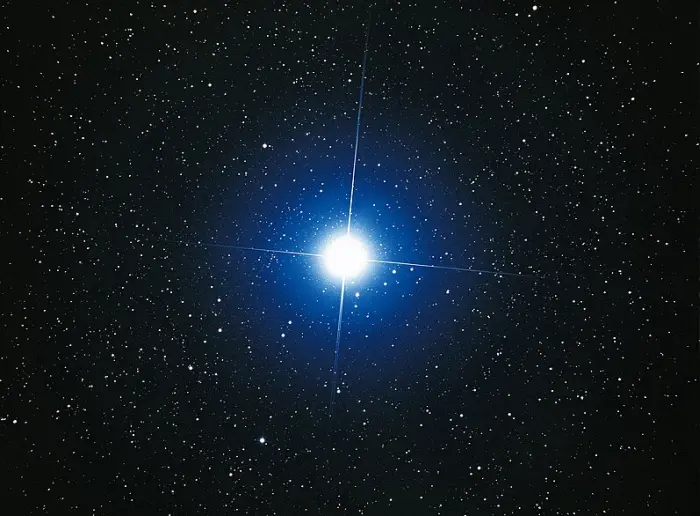
This ground-based image was taken by Japanese amateur astronomer Akira Fujii and shows a close-up of Sirius. Image credit: European Space Agency (ESA), Akira Fujii (CC BY 4.0)
At periastron (the closest approach), the two stars can only be resolved in a 12-inch or larger telescope. As they have been moving away from each other since the last periastron in 1994, Sirius A and Sirius B are easier to resolve.
Sirius A has a 2.063 times the Sun’s mass and a radius of 1.713 solar radii. It shines at magnitude -1.46 from a distance of 8.60 light-years. With an estimated age of 242 ± 5 million years, the star is considerably younger than the Sun (4.6 billion years).
Sirius has a projected rotational velocity of 16 km/s, which is not high enough to cause any marked flattening at its poles.
With an effective temperature of 9,845 K, the star is 24.7 times more luminous than the Sun. It has an absolute magnitude of +1.43.
Sirius A is a metallic-line star (Am star), with a spectrum that shows strong absorption lines of elements heavier than helium. It has 316% of the Sun’s abundance of iron.
The star’s spectral type, A0mA1 Va, indicates that Sirius A would have the classification A1 based on its hydrogen and helium lines, but it would belong to the spectral class A0 based on the absorption lines of metals. The high content of metals is believed to be mainly present in the surface layers, not in the entire star.
Sirius B, on the other hand, is considerably smaller and fainter, and yet it is one of the more massive white dwarfs ever discovered. It has an apparent magnitude of 8.44 and an absolute magnitude of 11.18. It lies a bit farther away than Sirius, at a distance of 8.709 light years.
The mass of Sirius B is only slightly greater than the Sun’s (1.018 solar masses) and its radius is only 0.008098 solar radii. In other words, the stellar remnant has the mass of the Sun packed into the size comparable to that of the Earth.
Sirius B has an estimated surface temperature of around 25,000 K, but shines with only 0.02448 solar luminosities. The white dwarf’s temperature will continue to gradually decrease over the next 2 billion years.
The estimated age of Sirius B is 228 million years. The star is a stronger source of X-ray radiation than Sirius A.
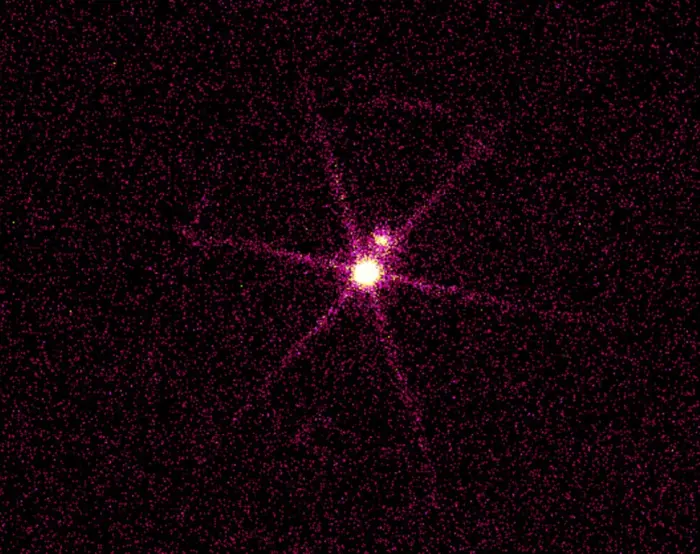
The Chandra X-ray image of Sirius A & B, a double star system located 8.6 light years from Earth, shows a bright source and a dim source. The central bright source is Sirius B, a dense white dwarf star with a surface temperature of about 25,000 degrees Celsius. The dim source (slightly above and to the right of Sirius B) is Sirius A, a normal star more than twice as massive as the Sun. The spoke-like pattern of light is an instrument artifact due to the transmission grating. The white dwarf, Sirius B, has a mass equal to the mass of the Sun packed into a diameter that is 90% that of the Earth. The gravity on the surface of Sirius B is 400,000 times that of Earth! Credit: NASA/CXC/SAO (Chandra X-ray Observatory) (PD)
Sirius B was once the more massive star in the system, which is why it evolved faster than its close neighbour.
The Alpha Canis Majoris system is believed to have initially consisted of two bluish-white stars locked in an elliptical 9.1-year orbit. Sirius B, originally a B-type star with an estimated mass of 5 solar masses, then evolved away from the main sequence and became a red giant about 120 million years ago. Eventually it puffed away its outer layers to form a planetary nebula (which has long faded) and became a white dwarf.
Sirius A will meet the same fate in the future. The star will exhaust the hydrogen supply in its core within its first billion years of life and evolve into a red giant before becoming a white dwarf. In comparison, our Sun, which has half the mass of Sirius, will take another 4-5 billion years to evolve away from the main sequence.
In 2024, a team of astronomers used modelling with MESA (Modules for Experiments in Stellar Astrophysics) and determined an age of 203.6 ± 45 million years for the Sirius system. They derived a mass of 1.015 ± 0.189 solar masses for the white dwarf, and a progenitor mass of 6.0 ± 0.6 solar masses.
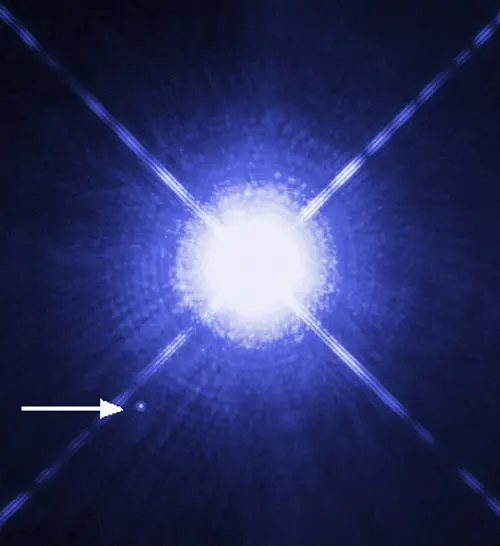
This Hubble Space Telescope image shows Sirius A, the brightest star in our nighttime sky, along with its faint, tiny stellar companion, Sirius B. Astronomers overexposed the image of Sirius A [at centre] so that the dim Sirius B [tiny dot at lower left] could be seen. The cross-shaped diffraction spikes and concentric rings around A*, and the small ring around Sirius B, are artifacts produced within the telescope’s imaging system. The two stars revolve around each other every 50 years. Sirius A, only 8.6 light-years from Earth, is the fifth closest star system known. The image was taken with Hubble’s Wide Field Planetary Camera 2. Image: NASA, ESA, H. Bond (STScI), and M. Barstow (University of Leicester) (PD)
Clark made the observation while testing an 18.5-inch great refractor telescope for the Dearborn Observatory at Northwestern University. This was the largest refractor ever built at the time. The sighting of the companion star was corroborated with smaller instruments on March 8.
American astronomer Walter Sydney Adams studied the spectrum of Sirius B in 1959 with a 60-inch reflector at Mount Wilson Observatory in California and found it to be a faint whitish star. Astronomers subsequently determined that the star was a white dwarf.
Sirius B was the second white dwarf to be discovered. The first one was found in the triple star system 40 Eridani.
In 2005, astronomers used data from the Hubble Space Telescope to measure the diameter of Sirius B and found that the stellar remnant was almost as large as Earth (12,000 km or 7,500 mi) and had 102% of the Sun’s mass.
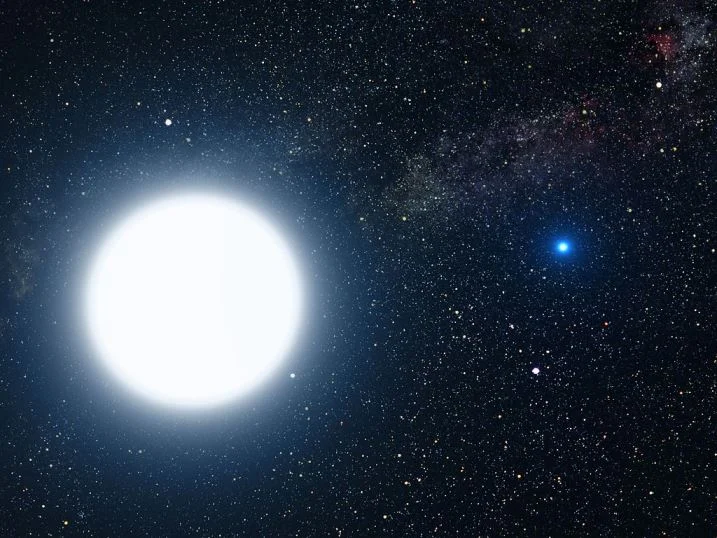
This picture is an artist’s impression showing how the binary star system of Sirius A and its diminutive blue companion, Sirius B, might appear to an interstellar visitor. The large, bluish-white star Sirius A dominates the scene, while Sirius B is the small but very hot and blue white-dwarf star on the right. The two stars revolve around each other every 50 years. White dwarfs are the leftover remnants of stars similar to our Sun. The Sirius system, only 8.6 light-years from Earth, is the fifth closest stellar system known. Sirius B is faint because of its tiny size. Its diameter is only 7,500 miles (about 12 thousand kilometres), slightly smaller than the size of our Earth. The Sirius system is so close to Earth that most of the familiar constellations would have nearly the same appearance as in our own sky. In this rendition, we see in the background the three bright stars that make up the Summer Triangle: Altair, Deneb, and Vega. Altair is the white dot above Sirius A; Deneb is the dot to the upper right; and Vega lies below Sirius B. But there is one unfamiliar addition to the constellations: our own Sun is the second-magnitude star, shown as a small dot just below and to the right of Sirius A. Image: NASA, ESA and G. Bacon (STScI) (PD)
Orbital irregularities observed since 1894 indicate the possibility of a third star in the system. If it exists, it is a very small star with a mass of 0.06 solar masses, in a six-year orbit around the primary star. However, no direct sightings have been reported yet.
Observations in 1995 led scientists to conclude that there was likely a third star in the system. The candidate star would have a mass of about 0.05 solar masses and an orbital period of 6 to 6.4 years. It would be separated from Sirius A by less than 3 arcseconds.
More recently, a survey with the Hubble Space Telescope ruled out the possibility of any object larger than a brown dwarf or a large exoplanet orbiting either Sirius A or Sirius B.
Observations with the VTL Survey Telescope in 2015 ruled out the presence of giant planets with 4 to 11 Jupiter masses orbiting the primary star during a survey that looked for evidence of planets in the Sirius system.
In 2021, an imaging search with the NIRC2 imager on the Keck II telescope at the W. M. Keck Observatory on Mauna Kea, Hawaii, did not detect any planetary companions around Sirius B.
Facts
With a visual magnitude of -1.46, Sirius is almost twice as bright as the second brightest star, Canopus (mag. -0.74). It is also much better known than Canopus north of the equator because it is visible from most places in the northern hemisphere. Canopus, on the other hand, lies in the far southern sky and stays below the horizon for observers in the mid-northern latitudes.
Sirius appears so bright both because it is intrinsically luminous, with an energy output about 24.7 times that of the Sun, and because of its proximity to the solar system. However, compared to other bright stars like Rigel (120,000 solar luminosities), Betelgeuse (65,000 to 87,000 L☉) and Canopus (16,600 L☉), or even Arcturus (170 L☉) and Capella (78.7 L☉), Sirius is not exceptionally luminous.
Even though it is exceptionally bright, Sirius never outshines the planets Jupiter and Venus. It sometimes also appears fainter than Mercury and Mars.
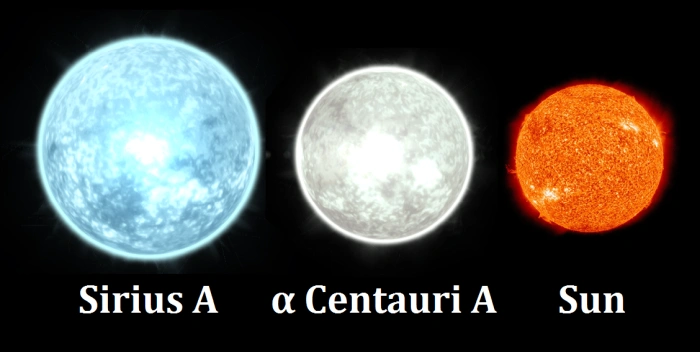
Size comparison between Sirius, Rigil Kentaurus (Alpha Centauri A) and the Sun, credit: NASA and Typhoon2021 (PD)
Sirius can sometimes be seen in the daylight from higher altitudes, when the sky is clear enough and the Sun is about to set.
Alpha Canis Majoris is the fifth nearest star system to Earth, after Alpha Centauri, Barnard’s Star, Wolf 359, and Lalande 21185. It contains two of the eight nearest stars. Alpha Centauri, the nearest star system to the Sun, lies at only half the distance (4.37 light years). Sirius is the seventh nearest star system if one includes the brown dwarf systems Luhman 16 and WISE 0855-0714.
The component Sirius A is the seventh individual closest star to the Sun, after Proxima Centauri, Rigil Kentaurus and Toliman in the Alpha Centauri system, Barnard’s Star, Wolf 359, and Lalande 21185.
Sirius is part of two prominent winter asterisms: the Winter Triangle and the Winter Hexagon. These star patterns dominate the evening sky throughout the winter months in the northern hemisphere.
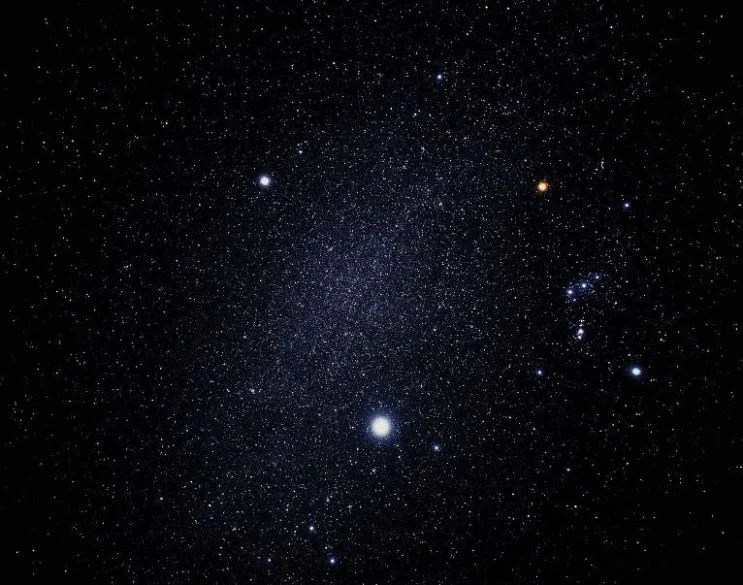
Procyon (upper left), Sirius (botton centre) and Betelgeuse (upper right), image: Hubble/European Space Agency, credit: Akira Fujii (CC BY 4.0)
The Dog Star forms the Winter Triangle with Betelgeuse, the second brightest star in Orion, and Procyon, the brightest star in the Canis Minor constellation. The asterism is sometimes also called the Great Southern Triangle.
The stars of the Winter Triangle form a larger asterism known as the Egyptian Cross or Egyptian X with Naos and Phact, the brightest stars in the constellations Puppis (the Stern) and Columba (the Dove). The Egyptian X is best seen from equatorial latitudes because Naos never rises for observers north of the latitude 60° N.
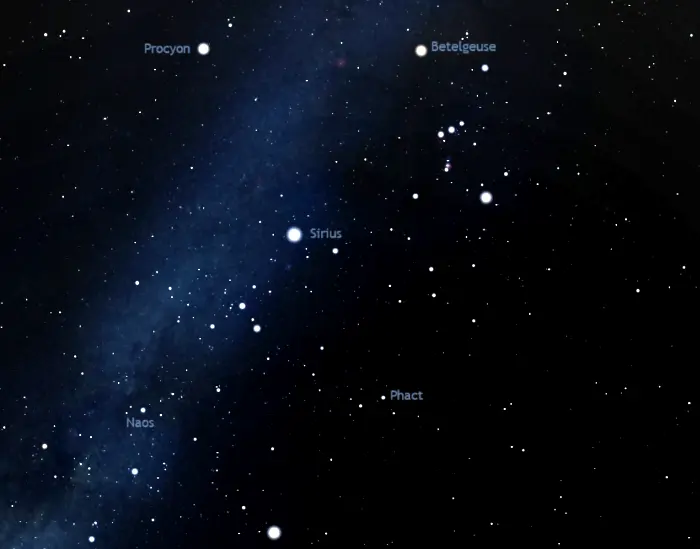
Egyptian X, image: Stellarium
The Winter Hexagon is a larger asterism formed by Sirius with Procyon in Canis Minor, Pollux in Gemini, Capella in Auriga, Aldebaran in Taurus, and Rigel in Orion. Also known as the Winter Circle, it is one of the brightest and largest asterisms in the night sky.
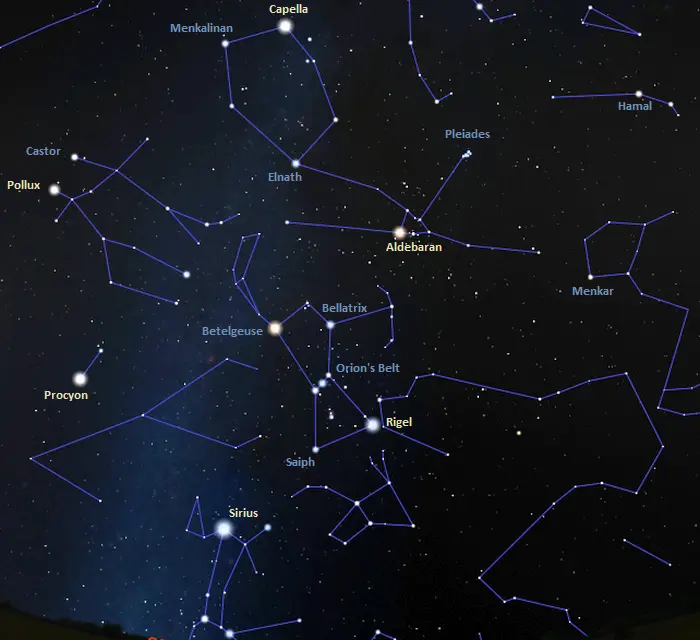
The stars of the Winter Hexagon: Rigel, Sirius, Procyon, Pollux, Capella, and Aldebaran, image: Stellarium
Sirius is slowly moving toward us and will gradually become a little brighter over the next 60,000 years. It will then start to move away and become slightly fainter. It will nevertheless stay the brightest star in our night sky for the next 210,000 years.
Sirius has not always been the brightest star in the sky. It took the title from Canopus about 90,000 years ago. Before Canopus, Capella was the brightest star and, before Capella, it was Aldebaran.
The brightest stars that held the title were Sirius’ neighbours in Canis Major, Adhara (mag. -3.99) and Mirzam (-3.65). The star that held the title the most times is Canopus, which will become the brightest star again after Vega has taken its turn after Sirius.
Precession and proper motion will gradually take Sirius further south and, around the year 9000, observers in northern and central Europe will no longer be able to see the star. Around the year 14000, Sirius will be at the declination -67°, which means that it will be circumpolar in South Africa and most places in Australia, but never rise above the horizon for observers north of the latitude 23° N.
Sirius’ closest large neighbour is Procyon, Alpha Canis Minoris. It is located only 5.24 light years (1.61 parsecs) away.
Sirius is one of the two Canis Major stars selected for use in the field of celestial navigation. The other one is Adhara, Epsilon Canis Majoris.
The astronomer Ptolemy of Alexandria, who wrote the Almagest, the only surviving comprehensive astronomical treatise from the 2nd century CE, described Sirius as “The [star] on the mouth, brightest, called ‘the Dog,’ and reddish.” He depicted Sirius as one of the six reddish stars, along with Aldebaran, Antares, Arcturus, Betelgeuse, and Pollux. The other five stars all appear orange or red and have the spectral types K or M, while Sirius is a class A star, appearing white or blue-white in colour.
Ptolemy’s description started a debate that has not yet come to a unified conclusion. His was not the only ancient reference to Sirius’ redness. The orator Cicero, philosopher Seneca and poet Aratus also called the star red, among others. Because it is not very likely that Sirius simply changed its colour from red to bluish-white within such a short period of time, this remains an unresolved mystery. To confuse things further, there are also many ancient texts calling the star white.
In 1985, citing an 8th century text written in Lombardy that described Sirius as reddish, German astronomers Wolfhard Schlosser and Werner Bergmann suggested that this further proved the theory that Sirius B was a red giant at the time. However, most astronomers reject stellar evolution as an explanation because there is no sign of nebulosity in the area and the timescale is too short. If Sirius B had expelled its outer layers in the last millennium, these would have formed a planetary nebula.
Another theory proposed that the star’s scintillations near the horizon may have been responsible for its red appearance. While this may be true, it does not address the fact that ancient sources neglected the same redness that was apparent in Rigel, Vega and other bright bluish or white stars when they were near the horizon.
In 1717, English astronomer Edmond Halley discovered the proper motion of stars. Stars were until then believed to be “fixed.” Halley’s discovery came after he had compared the data provided by Ptolemy in the Almagest with contemporary astrometric measurements. The astronomer found that Sirius had moved about 30 arcminutes – the width of the full Moon – to the southwest and noted that Arcturus and Aldebaran had moved as well.
Sirius was the first star to have its velocity measured. In 1868, English astronomer William Huggins studied the star’s spectrum and noted a redshift. His analysis led to the conclusion that the star was receding from the Sun at a velocity of about 40 km/s.
Sirius is now known to be approaching the solar system at 5.5 km/s. Huggins likely failed to take the Earth’s orbital velocity into account, which would explain an error of about 30 km/s. However, his work opened the door to the study of stars’ radial velocities.
There were numerous attempts to determine Sirius’ parallax and distance before Scottish astronomer Thomas Henderson made the first good estimate. Henderson observed the star in 1832 and 1833. He also used South African astronomer Sir Thomas Maclear’s observations made a few years later, in 1836 and 1837, to calculate the value of the parallax of 0.23 arcseconds, with a margin of error of up to a quarter of a second. The value of 0.25 arcseconds was accepted for most of the 19th century. Today Sirius is known to have a parallax of 0.3745 arcseconds and a distance of 2.64 parsecs.
In 1909, Danish astronomer Ejnar Hertzsprung proposed a theory that Sirius was a member of the Ursa Major Moving Group after making observations of the star’s movement in the sky. The Ursa Major Moving Group is a stellar association that includes most of the bright stars of the Big Dipper (all except Dubhe and Alkaid). The stars are believed to have formed in the same nebula about 300 to 500 million years ago, and they share a common motion through space.
However, a research conducted at Clemson University in South Carolina in 2003 indicated that Sirius was too young to be a member of the group and that it shared the same direction as the Ursa Major stars only by coincidence.
Sirius may instead belong to the Sirius Supercluster, along with a number of other relatively bright stars, including Alphecca (Alpha Coronae Borealis), Menkalinan (Beta Aurigae), Cursa (Beta Eridani), Beta Crateris, and Zhou (Beta Serpentis). Hipparcos observations in the late 1990s confirmed about 50 members. If this is correct, the Sirius Supercluster would be one of the three large star clusters within 500 light years of the solar system, along with the Pleiades and the Hyades.
Sirius has historically played an important role in many cultures. This is reflected in the fact that it has two stars that announce its rising. Procyon, the eighth brightest star in the sky and the luminary of Canis Minor, rises before Sirius when seen from most northern latitudes. Its name is derived from the Greek word Προκύων (Prokyon), which means “before the dog.”
Similarly, Mirzam (Beta Canis Majoris) was named for its position in the sky, heralding Sirius’ rising. Its name comes from the Arabic word for “the herald.”
Name
The name Sirius (pronunciation: /ˈsɪriəs/) comes from the Greek Σείριος (Seirios), meaning “scorching” or “glowing.” However, the name may have a different origin. Some sources propose that it might be associated with the Egyptian god Osiris.
The name was officially approved for Sirius A by the International Astronomical Union’s (IAU) Working Group on Star Names (WGSN) on June 30, 2016. Even though it formally only applies to the primary component in the system, it is also commonly used for the companion, Sirius B, and for the whole star system.
The name was first documented in the 7th century BCE in the Greek poet Hesiod’s work Works and Days.
Sirius is known by more than 50 names and catalogue designations. In medieval western Europe, the name Alhabor was used for the star on astrolabes (instruments for measuring stars’ altitudes above the horizon). The 14th century English poet and author Geoffrey Chaucer used this name for the star in his essay Treatise on the Astrolabe, which served as an instruction manual for the instrument.
German uranographer Johann Bayer used the name Aschere for the star. The name is derived from the Arabic ash-hira (الشِّعْرَى), meaning “the leader.” The star was mentioned under this name in the Qur’an (chapter Surah).
The star’s Sanskrit name is Mrgavyadha, meaning “the deer hunter.” The name refers to Rudra, a Rigvedic deity associated with hunting, storm and the Hindu god Shiva. In Sanskrit, Sirius is also known as Lubdhaka, “the hunter.”
In Scandinavian culture, Sirius has been known as Lokabrenna or “Loki’s torch,” in reference to the role Loki played in Ragnarok. In some pagan religions, Lokabrenna Day is celebrated on the day of the star’s heliacal rising.
The Chinese know Sirius as the star of the “celestial wolf” (天狼). In traditional Chinese astronomy, the star was part of the Mansion of Jǐng (the Well Mansion), which roughly corresponded to Gemini and several other nearby constellations.
Culture and mythology
To the ancient Greeks, the heliacal rising of Sirius (rising above the horizon at dawn after a period of invisibility) marked the “dog days” of summer. They would offer sacrifices to assuage the star’s effects, which were believed to be considerable, from causing plants to become dry to making people “star-struck.”
If Sirius rose clear, it heralded a season of good fortune, but if it rose faint or dim, the Greeks believed it brought pestilence. The extent of Sirius’ importance on the Aegean island of Kea (Ceos) has been confirmed by the coins that were discovered on the island, that date back to the 3rd century BCE. They featured depictions of dogs or stars with rays.
The Romans also offered sacrifices to the gods on the day of Sirius’ heliacal rising. They would sacrifice a dog and make an offering of wine, sheep and incense to the goddess Robigo so that the star would not cause wheat rush on their crops.
Sirius is associated with dogs in many cultures. The constellation Canis Major is usually depicted as one of the dogs following Orion, the Hunter (the other being Canis Minor). The Greeks believed that the star could affect dogs and make them behave oddly in the peak of summer.
In ancient Rome, the “dog days of summer” were known as dies caniculares and Sirius itself was known as Canicula, meaning “little dog.”
The Native American peoples of North America also associated the star with dogs. The Blackfoot knew it as “Dog-face,” the Inuit people of the Bering Strait called it “Moon Dog,” the Seri and the Tohono Oʼodham associated it with a dog following sheep, the Pawnee Wolf tribe called it the “Wolf Star.” Other Pawnee of Nebraska used the name “Coyote Star.” The Cherokee knew Sirius and Antares as a dog-guardian guarding the “Path of Souls.”
In ancient Egypt, the star’s heliacal rising coincided with the flooding of the Nile. Because the star has an extraordinarily regular heliacal rising, with a period of 365.25 days, almost equal to the solar year, it was important to the ancient Egyptians, in part because of the erratic timing of the flood. The heliacal rising occurs on July 19 in Cairo, just before the summer solstice and the flooding.
In Egypt, the star was associated with Sopdet (known as Sothis to the Greeks), who was worshipped as a goddess of fertility. Fertility was brought to the soil by the annual flood. The Egyptian civil calendar – which consisted of three seasons of 120 days and an intercalary month of five days for a total of 365 days – reflected the importance of Sirius. The star’s rising coincided with Mesori, the month known as the “Opener of the Year.”
In ancient Persian tales and in Zoroastrianism, Sirius was known as Tishtrya, the divinity that fought the demon of drought and brought rain and fertility.
In Polynesia, Sirius was an important star in navigation around the numerous Pacific islands and atolls. The star also heralded winter. Ancient Polynesians used bright stars as latitude markers and Sirius was very useful to them because its declination corresponds to the latitude of the Fiji archipelago at 17° S, which means that the star moves directly over the islands every night.
Ancient Polynesians considered Sirius to be part of Manu, a “Great Bird” constellation. The bright stars Canopus and Procyon represented the bird’s southern and northern wingtips. The Manu constellation divided the night sky into two hemispheres.
Inhabitants of Polynesian islands had many different names for Sirius. In Hawaii, the star’s culmination in the sky at the winter solstice was celebrated each year. The star was known as Ka’ulua, meaning “the Queen of Heaven.” The Hawaiian people knew the star as Kaulua-ihai-mohai, or “the flower of the heavens”, Kaulua-lena or “yellow star”, Aa (“glowing”) and Kau-ano-meha, meaning “standing-alone-and-sacred.”
In New Zealand, Sirius was known as Rehua. In the Marquesas Islands, it was called Tau-ua, and in Pukapuka, it was known as Tokiva.
The Māori people of New Zealand called the star Takurua. Sirius marked the beginning of winter, and the Māori had the same name for the second month of their lunar calendar, which roughly corresponded to July (southern hemisphere winter).
The Boorong people of northwest Victoria in Australia called the star Warepil. In local lore, Warepil was the brother of War (Canopus), who introduced fire to humankind. Warepil was associated with the wedge-tailed eagle, the chief of the spirit elders who created the land and were the first to inhabit it.
Sirius is one of the 27 stars representing Brazilian Federative Units on the flag of Brazil. It represents the state of Mato Grosso.
Sirius was associated with a bow and arrows in some ancient cultures. The Chinese depicted the stars of Canis Major and Puppis as a large bow and arrow, with the tip of the arrow pointed at Sirius, representing a wolf.
The Persians knew the star as Tir and associated it with an arrow. At the Dendera Temple complex in Egypt, the temple dedicated to the goddess Hathor featured a depiction of the goddess Satet drawing an arrow at Hathor (Sirius).
Sirius has been referenced in countless works of fiction over the centuries. It is mentioned in the works of Homer, Dante, John Milton, John Dryden, Voltaire, Alfred Lord Tennyson, J. R. R. Tolkien, and many other classical and contemporary writers.
The star was prominently used in many works of science fiction, among others in Isaac Asimov’s Foundation series (1942 – 1993), Eric Frank Russell’s Wasp (1957), Edmund Cooper’s Seed of Light (1959), Jack Vance’s Space Opera (1965), Frederik Pohl’s The Age of the Pussyfoot (1969), Douglas Adams’ The Hitchhiker’s Guide to the Galaxy (1979), Doris Lessing’s The Sirian Experiments (1980), Yoshiki Tanaka’s Legend of the Galactic Heroes (1982), Arthur C. Clarke’s The Songs of Distant Earth (1986), and Peter F. Hamilton’s Great North Road (2012).
Sirius is also associated with various esoteric beliefs. In theosophy, the star is believed to be the recipient of the spiritual energy of the Seven Primeval Rays (angels or gods), transmitted by the Seven Stars of the Pleiades first to the seven bright stars of the Big Dipper and then to Sirius. The energy is then believed to be sent to the Lord Sanat Kumara (lord or regent of the humanity) via the Sun and then through the seven Masters of the Ancient Wisdom (enlightened beings also called the Elder Brothers of the Human Race) to the human race.
The Serer people in West Africa (Senegal, northern Gambia and southern Mauritania) call Sirius Yoonir. The star has exceptional importance in their religious cosmology. It represents the universe, transcendence and the sign of the supreme deity (Roog), as well as humans on Earth. The star heralds the beginning of flooding and enables Serer farmers to start planting seeds.
In medieval astrology, Sirius was one of the 15 Behenian fixed stars, which were considered to be a source of magical power. The Behenian stars were associated with plants and gemstones that were used in rituals to bring out the stars’ power. Sirius was associated with beryl and juniper and linked with the planet Venus.
Sirius and the Dogon
The Dogon people in Mali, West Africa, worshipped the Nommo, ancestral spirits, who they believed inhabited a planet orbiting Sirius. The book The Sirius Mystery (1976) by Robert K. G. Temple brought Dogon beliefs into the spotlight, proposing that their knowledge of astronomy could only be explained if they had obtained it from an extraterrestrial race. Temple associated these hypothetical aliens with the myth of the Nommos.
However, he was not the first to take interest in the Dogon belief system. French anthropologist Marcel Griaule studied the tribe between 1931 and 1956. He reported that they believed that Sirius had two companion stars and that one of these stars had an orbital cycle of 50 years. Since Sirius B is invisible to the unaided eye and it was not until 1844 that its existence was even inferred, the Dogons’ knowledge of it was a mystery.
Temple’s theory, however, was disputed by several authorities on the subject, who pointed out that the tribe could have gained the knowledge from a group of astronomers who had visited their territory to study the solar eclipse that occurred on April 16, 1893. In an article published in Current Anthropology in 1991, anthropologist Walter van Beek, who had also studied the Dogon, reported that members of the tribe disagreed on which star it was that they referred to as sigu tolo, but that they did agree that they had heard about it from Griaule.
The Dogon mystery was used or referenced in several works of fiction, including Philip K. Dick’s V.A.L.I.S. (1981), Tom Robbins’ Half Asleep in Frog Pajamas (1994), Ian Douglas’ Battlespace (the second book in the Legacy Trilogy, published in 2006), and Grant Morrison’s The Invisibles comic book series (1994-2000).
Location
Sirius is the easiest star to find in the sky, both because it is brighter than all other stars and because of its proximity to the familiar hourglass shape formed by the brightest stars of Orion. The three stars of Orion’s Belt – Alnitak, Alnilam and Mintaka – point directly at Sirius.
Sirius is visible from most locations on Earth. Places in the far northern latitudes, north of 73° N, are the exception. The star does not climb very high above the horizon in northern latitudes slightly south of 73° N and cannot be seen at all north of 73° N.
Southern observers can see Sirius regardless of latitude. In places south of the latitude 73° S, the star is circumpolar, i.e. it never sets and can be seen throughout the year.
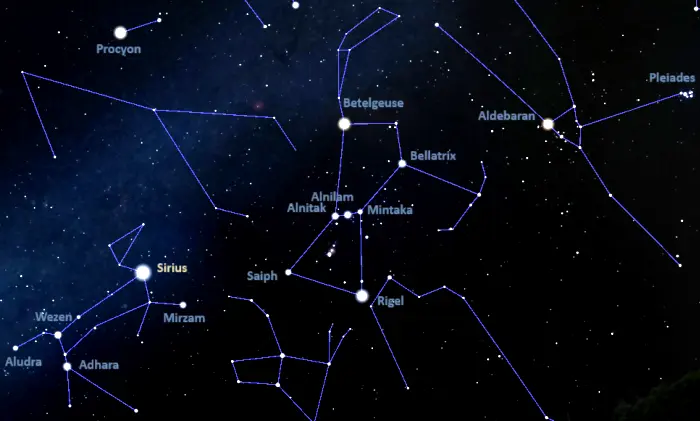
The location of Sirius (Alpha Canis Majoris), image: Stellarium
Sirius lies in the vicinity of several interesting deep sky objects. Messier 41, a magnitude 4.5 open cluster, lies only 4 degrees south of the star. Its stars can be resolved in a small telescope. The emission nebula Sharpless 301 (Sh2-301) appears in the same area.
The emission nebula NGC 2359, nicknamed the Thor’s Helmet Nebula, lies about 8 degrees northeast of Sirius. The large H II region IC 2177, also known as the Seagull Nebula, is located in the same area of the sky, on the border with the constellation Monoceros (the Unicorn).
The bright open cluster Messier 47 lies 12 degrees east and 2 degrees north of Sirius. Another open cluster, Messier 46, appears in the same field of view. Both clusters are located in the constellation Puppis.
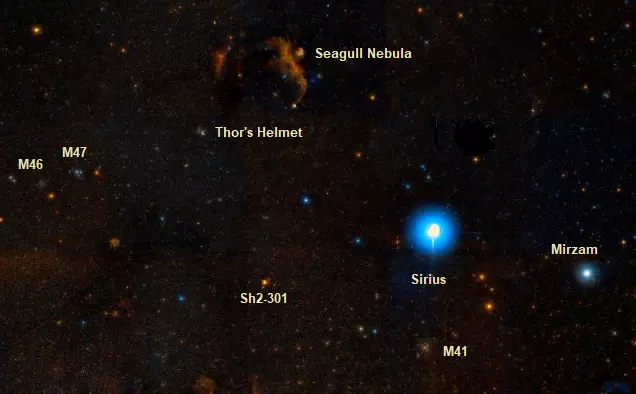
Sirius, Mirzam, Messier 41, Messier 46, Messier 47, the Seagull Nebula, Sharpless 301 and Thor’s Helmet, image credit: ESO/Digitized Sky Survey 2 (CC BY 4.0)
Constellation
Sirius is located in the constellation Canis Major, the Greater Dog. Canis Major is one of the Greek constellations, listed by the Greco-Roman astronomer Ptolemy in his Almagest in the 2nd century CE. In Greek mythology, it represents the bigger dog following Orion, the Hunter. The smaller dog is represented by the constellation Canis Minor. Canis Major is sometimes also associated with Laelaps, the mythical dog that never failed to catch its prey.
The Great Dog is the 43rd largest constellation in the sky, occupying an area of 380 square degrees. With five stars brighter than magnitude 3.0, it is one of the brightest southern constellations.
Canis Major is best-known for being home to Sirius, the brightest star in the sky. Most of the constellation’s other bright stars are massive, hot, blue supernova candidates, including the blue bright giants Adhara (Epsilon Canis Majoris), Mirzam (Beta Canis Majoris) and Tau Canis Majoris, the blue supergiants Aludra (Eta Canis Majoris), Omicron2 Canis Majoris and Iota Canis Majoris, the blue giant Xi1 Canis Majoris, and the B-type main sequence stars Kappa Canis Majoris and Omega Canis Majoris.
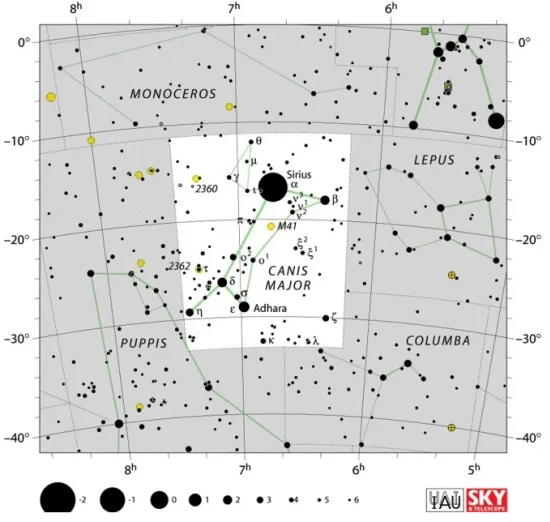
Canis Major constellation map by IAU and Sky&Telescope magazine (Roger Sinnott & Rick Fienberg) (CC BY 3.0)
Other notable stars in the constellation include the yellow-white supergiant Wezen (Delta Canis Majoris), the hot B-type main sequence star Furud (Zeta Canis Majoris), the orange supergiants Unurgunite (Sigma Canis Majoris) and Omicron1 Canis Majoris, the orange giant Nu2 Canis Majoris, the blue bright giant Muliphein (Gamma Canis Majoris), and the Wolf Rayet stars EZ Canis Majoris, the central star of the Dolphin Head Nebula (Sh2-308), and WR 7, the central star of the Thor’s Helmet Nebula (NGC 2359).
Canis Major also hosts the red hypergiant VY Canis Majoris, one of the largest stars known.
Deep sky objects in the constellation include the bright open clusters Messier 41, Caroline’s Cluster (NGC 2360), NGC 2354, and the Tau Canis Majoris Cluster (NGC 2362), the emission nebulae NGC 2359 (the Thor’s Helmet Nebula) and the Dolphin Head Nebula (Sharpless 308), the disputed Canis Major Dwarf Galaxy (the Canis Major Overdensity), and the interacting spiral galaxies NGC 2207 and IC 2163.
The best time of the year to see the stars and deep sky objects in Canis Major is during the month of February, when the constellation appears higher above the horizon in the early evening. The entire constellation is visible from locations south of the latitude 60° N.
The 10 brightest stars in the constellation are Sirius (Alpha CMa, mag. -1.46), Adhara (Epsilon CMa, mag. 1.50), Wezen (Delta CMa, mag. 1.824), Mirzam (Beta CMa, mag. 1.985), Aludra (Eta CMa, mag. 2.45), Furud (Zeta CMa, mag. 3.025), Omicron2 Canis Majoris (mag. 3.043), Unurgunite (Sigma CMa, mag. 3.43 – 3.51), Kappa Canis Majoris (mag. 3.40 – 3.97), and Omicron1 Canis Majoris (mag. 3.78 – 3.99).
Sirius – Alpha Canis Majoris
| Spectral class | A0mA1 Va + DA2 |
| Apparent magnitude | -1.46 |
| Constellation | Canis Major |
| Right ascension | 06h 45m 08.91728s |
| Declination | -16° 42′ 58.0171” |
| Designations | Sirius, Alpha Canis Majoris, α Canis Majoris, α CMa, 9 Canis Majoris, 9 CMa, Dog Star, Canicula, Aschere, HD 48915, HIP 32349, HR 2491, SAO 151881, LTT 2638, ADS 5423, GJ 244, BD−16°1591, LHS 219, GC 8833, 2MASS J06450887-1642566, Al Shira, Alhabor, Sothis, Tenrōsei, Mrgavyadha, Lubdhaka |
Sirius A
| Spectral class | A0mA1 Va |
| U-B colour index | -0.05 |
| B-V colour index | +0.00 |
| Apparent magnitude | -1.46 |
| Absolute magnitude | +1.43 |
| Distance | 8.60 ± 0.04 light years (2.64 ± 0.01 parsecs) |
| Parallax | 379.21 ± 1.58 mas |
| Radial velocity | -5.50 ± 0.4 km/s |
| Proper motion | RA: -546.01 ± 1.33 mas/yr |
| Dec: -1,223.07 ± 1.24 mas/yr | |
| 379.21 ± 1.58 mas | |
| Mass | 2.063 ± 0.023 M☉ |
| Luminosity | 24.7 L☉ |
| Radius | 1.713 ± 0.009 R☉ |
| Surface gravity | 4.33 cgs |
| Temperature | 9,845 ± 64 K |
| Metallicity | 0.50 dex |
| Age | 242 ± 5 million years |
| Rotational velocity | 16 km/s |
| Right ascension | 06h 45m 08.91728s |
| Declination | -16° 42′ 58.0171” |
| Designations | Sirius, Sirius A, Alpha Canis Majoris A, α CMa A, HD 48915A, HR 2491, HIP 32349, SAO 151881, GJ 244 A, BD-16 1591A, FK5 257, PPM 217626, CEL 1368, Ci 20 396, CNS5 1676, GC 8833, GCRV 4392, LTT 2638, NLTT 16953, NSV 17173, PLX 1577, USNO 816, CSI-16 1591 1, JP 11 1423, LFT 486, LHS 219, LPM 243, RAFGL 1007, PMC 90-93 186, PM 06430-1639A, N30 1470, GAT 474, GEN# +1.00048915A, SKY# 11855, SBC7 288, SBC9 416, HGAM 556, IRC -20105, AKARI-FIS-V1 J0645085-164258, WEB 6525, UBV 6709, UBV M 12413, Zkh 91, uvby98 100048915 A, 8pc 379.21A, IRAS 06429-1639, IRAS S06429-1639, IRAS S06430-1639, 2MASS J06450887-1642566, TD1 8027, TIC 322899250, TYC 5949-2777-1, ADS 5423 A, CCDM J06451-1643A, IDS 06408-1635 A, WDS J06451-1643A |
Sirius B
| Spectral class | DA2 or DA 1.9 |
| U-B colour index | -1.04 |
| B-V colour index | -0.03 |
| Apparent magnitude | 8.44 |
| Absolute magnitude | +11.18 |
| Distance | 8.709 ± 0.005 light-years (2.670 ± 0.002 parsecs) |
| Parallax | 374.4896 ± 0.2313 mas |
| Proper motion | RA: −461.571 ± 0.278 mas/yr |
| Dec.: −914.520 ± 0.332 mas/yr | |
| Mass | 1.018 ± 0.011 M☉ |
| Luminosity | 0.02448 ± 1.3% L☉ |
| Radius | 0.008098 ± 0.6% R☉ |
| Surface gravity | 8.57 cgs |
| Temperature | 25,000 ± 200 K |
| Age | 228 million years (220 – 238 Myr) |
| Right ascension | 06h 45m 09.3041925037s |
| Declination | -16° 43′ 00.724740067” |
| Designations | Sirius B, Alpha Canis Majoris B, α CMa B, HD 48915B, GJ 244 B, BD-16 1591B, CNS5 1675, CSI-16 1591 3, WD 0642-16, WD 0643-16, WD 0642-166, WD 0642-163, EGGR 49, GCTP 1577.00, AGC 1BC, 1E 064255-1639.3, 1E 064255-1639.4, 2E 1730, 2E 0642.9-1638, 1ES 0642-16.6, EUVE J0645-16.7, 2EUVE J0645-16.7, H 0643-16, GEN# +1.00048915B, RX J0645.1-1642, 1RXS J064509.3-164241, 2RXF J064508.6-164240, RE J0645-16, RE J0645-164, RE J064509-164243, 2RE J0645-164, 2RE J064509-164243, UBV 6710, 8pc 379.21B, Zkh 92, Gaia DR2 2947050466531873024, Gaia DR3 2947050466531873024, ADS 5423 B, CCDM J06451-1643BC, IDS 06408-1635 B, WDS J06451-1643BC |